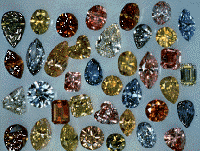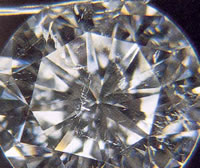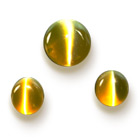DIAMOND SOURCE OF VIRGINIA NEWS: LAS VEGAS TRADE SHOW
The first weekend of June is the date of the largest diamond and jewelry trade show in the country. Thousands of diamond suppliers, colored gemstone suppliers and jewelry designers from all over the world bring their best products to Las Vegas to market to retailers.
This is always a great opportunity for our clients who are seeking exceptional jewelry items or colored gemstones. Every year we take our client shopping list to this trade show and are able to find the best of the best in the world for unique jewelry items, breathtaking colored gemstones or other hard to find items.
If you need a special gift, give us a call today so we can start researching now and add your requests and requirements to our shopping list. It is a once a year chance for us to handpick the most beautiful jewelry items in the world.
WEB SITE HIGHLIGHTS: COLORED DIAMONDS
 Diamonds come in a variety of colors. The majority of diamonds sold in the jewelry industry range from near colorless to very light yellow or brown. The most valuable are colorless diamonds (which have extraordinary ability to absorb all rays of light equally) and fancy colored diamonds (due to their rarity and uniqueness).
Diamonds come in a variety of colors. The majority of diamonds sold in the jewelry industry range from near colorless to very light yellow or brown. The most valuable are colorless diamonds (which have extraordinary ability to absorb all rays of light equally) and fancy colored diamonds (due to their rarity and uniqueness).
Our web site has information and photos of a wide variety of colored diamonds.
Learn more about colored diamonds…
DIAMOND SHOPPER MISTAKES: CUT IS KEY TO BEAUTY
 Many diamond shoppers assume that high color and high clarity translate into high quality and a beautiful diamond. This misperception has been fostered by jewelers promoting high cost diamonds, scam artists promoting “investment” diamonds and a general lack of understanding about what produces brilliance and sparkle in a diamond.
Many diamond shoppers assume that high color and high clarity translate into high quality and a beautiful diamond. This misperception has been fostered by jewelers promoting high cost diamonds, scam artists promoting “investment” diamonds and a general lack of understanding about what produces brilliance and sparkle in a diamond.
Cutting, more than any other factor, determines the beauty and brilliance of a diamond. A “D” color diamond, though high on the color scale, may lack beauty and brilliance due to poor cutting. A flawless diamond may also lack beauty and brilliance due to poor cutting. In order to find a diamond that is both beautiful and brilliant, it is necessary to first search for a diamond that is well proportioned, and then to balance out the color, clarity, and size with budgetary considerations.
A D color, Internally Flawless diamond sounds impressive but if the diamond has poor cut, low polish and symmetry, strong fluorescence it will be less attractive than a diamond with great cut, clean to the eye clarity and a “near colorless” color grade.
We are amazed at how many shoppers request a D color, Internally Flawless diamond but don’t seem to be concerned about the cut of the diamond.
Discover more shopping advice secrets
DIAMONDS TO DAZZLE AT SOTHEBYS
A dazzling array of jewels will go on sale at Sotheby’s in New York next month. Highlights include the rarest of colored diamonds, white diamonds and gemstones, and beautiful pieces by some of the most important 20th-century American jewelers.
An exhibition will be held in New York from April 8-12. Among the diamonds on sale is an intense blue diamond weighing 3.12 carats (estimated at $450,000-$550,000). From a private collection, the pear-shaped stone’s graceful proportions suggest it was cut at the turn of the 20th century. The blue color is a result of boron content, and only 2% of all diamonds exhibit this color.
Another extraordinary stone is a green diamond weighing 0.9 carats ($300,000-$400,000). Natural green diamonds are among the rarest of all diamonds, and this stone is further distinguished by its round shape.
The sale will also feature a selection of classic white diamonds, including a pear-shaped diamond pendant weighing 20.05 carats, set in a simple platinum mounting ($600,000-$700,000).
n addition to rare and exquisite diamonds, a range of other jewelry will be on offer. Kashmir in India is known for its extraordinary natural beauty as well as for beautiful sapphires. Included in the sale is an exquisite 9.41 carat cushion-shaped sapphire of Kashmiri origin, set in a platinum ring mounting flanked by two calf’s-head-cut diamonds ($150,000/$200,000).
DIAMOND PRICES IMPACTED BY SUPPLY AND DEMAND
DeBeers is poised to further increase diamond rough prices in 2005 after significantly increasing prices by approximately 15-20% in 2004 and setting record sales for the year.
The world’s biggest diamond producer, De Beers, is expected to have raised sales by 4.7%, to $5.76-billion, in 2004 thanks to higher prices and growing demand.
In 2002, DeBeers saw a 2% increase in consumer demand worldwide, in 2003 a 4% increase, and in 2004 6%, or even higher.
 DTC, De Beers’ marketing arm, said last August it had raised rough diamond prices by an average of five percent after recording a 7% rise in sales during the first six months of the year. The August hike followed price increases of 3% and 5% in January and March, respectively.
DTC, De Beers’ marketing arm, said last August it had raised rough diamond prices by an average of five percent after recording a 7% rise in sales during the first six months of the year. The August hike followed price increases of 3% and 5% in January and March, respectively.
With many of the older diamond mines in Africa and Australia seeing diamond production dwindle as the “easy” mining is winding down and more expensive underground mining is ahead, the new mines in Canada can not open fast enough to keep up with the world wide increases in demand. The DTC has been very successful at growing demand in Japan, China and other countries in addition to the United States.
In recent years, the diamond industry has had a surplus of diamonds as the stockpiles of Russian diamonds and those held by DeBeers were gradually released to the market. The surplus of diamonds, even though declining, helped to keep diamond prices in a stable but gradual upward trend even though the demand for diamonds was growing at a faster pace than production.
Now that the surplus is gone, the pressure of demand being greater than production has erupted in the price increases during 2004 and the expected price increases for the foreseeable future. Diamond cutters and wholesalers tell us that they just can not find enough rough and cut diamonds in larger sizes and quality so those are the areas that will likely see the most pressure upward on prices.
If you purchased your diamond several years ago, be grateful and be sure your insurance appraisal value is current. If you are shopping for diamond now or considering upgrading in the future, our advice is to think about purchasing sooner rather than later. With price increases of 10-15% a year, it is hard to save money for that special purchase faster than the prices are going up.
Learn more about diamond prices…
INCLUSIONS & BLEMISHES: TWINNING WISPS
 The term Twinning Wisps, also known as Intergrowth, is used to describe the configuration of inclusions which have twisted together within a twinning plane. The configuration might include a variety of inclusions such as pinpoint size diamond crystals, fractures, crystals, feathers and clouds. The twinning wisp is an inclusion resulting from crystal distortion during growth. The pattern often looks like white striping that is flat and ribbon-like, and usually radiate out from the diamond’s center.
The term Twinning Wisps, also known as Intergrowth, is used to describe the configuration of inclusions which have twisted together within a twinning plane. The configuration might include a variety of inclusions such as pinpoint size diamond crystals, fractures, crystals, feathers and clouds. The twinning wisp is an inclusion resulting from crystal distortion during growth. The pattern often looks like white striping that is flat and ribbon-like, and usually radiate out from the diamond’s center.
Twinning wisps are most often found in fancy shape diamonds such as pear shapes, heart shapes and triangles because they are often fashioned from twinned crystals, however twinning wisps can appear within other diamond shapes as well depending on the quality of the diamond rough that was used to make the stone.
A twinning wisp is just an internal growth feature of the diamond crystal. It’s not a durability risk.
We have sold some beautiful large diamonds with substantial twinning wisps visible under the microscope but clean to the eye because of their white, wispy nature. The nature of the twinning wisps is such that the appearance of the diamond and the visibility of the inclusions to the eye are often much better than the clarity grade would imply. In other words, twinning wisps often provide great values in the search for lower priced beautiful diamonds.
CANADIAN DIAMONDS: VALUE ADDED
 Canada’s current production comes from two mines. The first is the Ekati Mine, owned by BHP-Billiton (80%), Chuck Fipke (10%) and Stewart Blusson (10%). The projected mine life for Ekati is 21 years and is expected to produce a gross value of approximately $9.5 billion (C). During its initial three years of operation, BHP Diamonds Inc. (now BHP Billiton Diamonds Inc.) sold 35% of its production to the De Beers Diamond Trading Company (DTC). That contract ended in 2002 and BHP-Billiton markets most of its all Canadian production on the open market.
Canada’s current production comes from two mines. The first is the Ekati Mine, owned by BHP-Billiton (80%), Chuck Fipke (10%) and Stewart Blusson (10%). The projected mine life for Ekati is 21 years and is expected to produce a gross value of approximately $9.5 billion (C). During its initial three years of operation, BHP Diamonds Inc. (now BHP Billiton Diamonds Inc.) sold 35% of its production to the De Beers Diamond Trading Company (DTC). That contract ended in 2002 and BHP-Billiton markets most of its all Canadian production on the open market.
The Diavik Mineis the other mine and it is a joint venture, owned by Rio Tinto (60%) and Aber Corporation (40%). Aber is the only fully Canadian-owned corporate producer. Throughout its 20-year mine life, Diavik will produce a gross value of approximately $10 billion (C).
Once the rough diamonds are mined and processed at the Ekati and Diavik mines, they are transported to Yellowknife, where each company has its own sorting and valuation facility. Under the Canada Mining Regulations, before the diamonds are permitted to leave the NWT, each company must have their diamonds sized and pre-sorted for valuation by the Canadian Government Diamond Valuator (GDV).
Under an arrangement with the Government of the Northwest Territories, Ekati and Diavik make approximately 10% by value of their respective productions available to three of the cutting and polishing factories in Yellowknife. The diamond industry is providing high-paying, high-tech jobs and other downstream benefits that have come as a direct result of the development of Diavik and Ekati.
On a national scale, the economic impact of diamond mining is relatively low for Canada. However, for the Northwest Territories, the picture is dramatically different. At about 20% of GDP, the major contribution diamond exploration and mining has made to that economy and the importance of benefits that can be derived regionally from such activity will be driving factor in their economy for many years.
GEMSTONES: CHRYSOBERYL
Chrysoberyl is a hard, tough, and durable gem. Although it lacks fire, specimens are very valuable. Most chrysoberyl gems are yellow, and some are brown or green. A rare and costly variety, known as alexandrite, exhibits different colors in natural and artificial light. If viewed in sunlight, its color is dark yellow-green to greenish-blue. If viewed in artificial light, its color is strawberry-red. Alexandrite was discovered on the birthday of the Russian Czar Alexander II, and was named in his honor.
 Another expensive form of chrysoberyl is the unusual cat’s eye variety. When polished as cabochons, these stones exhibit a narrow band of concentrated light along the width of the gem. This effect, known as cat’s eye effect, is caused by inclusions of fine, slender parallel fibers in the gem. Like the eye of a panther, cat’s-eye chrysoberyl seems almost supernatural in origin. How could something so feline be mineral and not animal?
Another expensive form of chrysoberyl is the unusual cat’s eye variety. When polished as cabochons, these stones exhibit a narrow band of concentrated light along the width of the gem. This effect, known as cat’s eye effect, is caused by inclusions of fine, slender parallel fibers in the gem. Like the eye of a panther, cat’s-eye chrysoberyl seems almost supernatural in origin. How could something so feline be mineral and not animal?
The color ranges from a honey-brown to an apple green with rich gold colors generally the most valued. The most important value factor is the strength and sharpness of the eye. Fine cat’s-eye chrysoberyl often also shows the “milk and honey” effect. When a bright light source is directed at the side of the stone, one side of the eye will be milky white and the other remains gold. When the stone is rotated, the colors switch. Cat’s-eyes are especially popular in men’s jewelry.
The cat’s eye variety may be called “cat’s eye”, cat’s eye, “precious cat’s eye”, “oriental cat’s eye”, “catseye”, or “chrysoberyl cat’s eye”. Many other gems also exhibit a cat’s eye effect, but only chrysoberyl’s cat’s eye enjoys the privilege of having the name “cat’s eye”. (All other gems that exhibit a cat’s eye effect must have the gem name proceeding, such as “quartz cat’s eye”, whereas chrysoberyl’s cat’s eye is known simply as “cat’s eye”.) In some chrysoberyl, the cat’s eye effect is weak. It appears as a billowy, floating light reflection as opposed to a bright, concentrated band of light. Such chrysoberyl is known as cymophane, and the effect is called “cymophane effect”.
All colors of chrysoberyl are faceted as gems for jewelry. The most common color for jewelry is yellow, but brownish and greenish stones are also seen. Alexandrite is faceted with the brilliant and cushion cuts, to make the color change most recognizable. Cat’s eyes are cut into cabochons.
Cat’s-eye is said to increase powers of perception and insight. It should also give greater discrimination in action. The ancients believed that cat’s eye protected individuals from epidemics or diseases, from drowning and from enemies, as well as heightening psychic perceptions. Coincidentally it is supposed to bring good fortune to gamblers.
